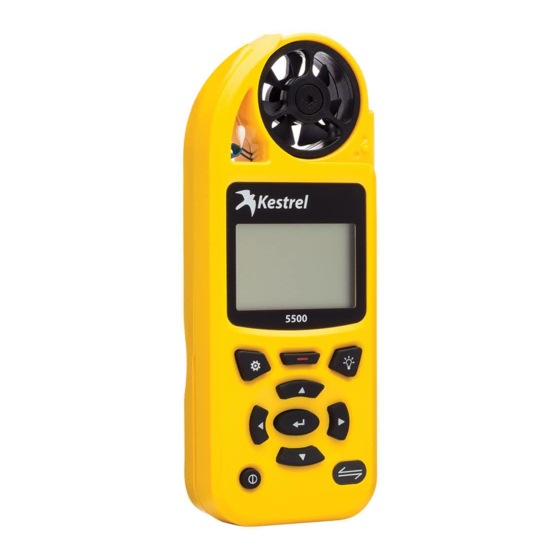
Kestrel 5500 Quick Manual To Using
Hide thumbs
Also See for 5500:
- Quick start manual (11 pages) ,
- User manual (24 pages) ,
- Manual (17 pages)
Table of Contents
Advertisement
Quick Links
Quick Guide to using the Kestrel 5500 as
a weather station
Introduction
The Kestrel weather station uses five sensors to measure temperature, humidity, wind
speed, wind direction and pressure. It displays these in real time, shows graphs of how
they have varied, and stores data from them which can be transmitted later using
Bluetooth to a PC, mobile phone or other device.
The Kestrel has a wide range of options, which can be a bit bewildering until you get
used to them. This guide assumes it is being used as a stand-alone weather station, to
be left recording for some hours or days and the data downloaded, rather than handheld
with data read manually. Notes at the end refer to places in the text where the Kestrel
capability can be extended or changed.
When you receive it from the RMetS, it will have been set for simplicity to show the
quantities it measures directly, in metric units: Temperature (⁰C), Relative Humidity (%),
Wind Speed (m/s), Wind Direction (degrees) and Pressure (corrected to sea level, hPa).
See Note 1 and Note 2 on how to change these settings.
The Kestrel has a great User Guide (UG), which you should read the first time you use it,
but it can be a bit daunting for everyday use. Here are the main things you need to
know.
Using the Kestrel
Switch on the display with
(It switches off after 15mins but still logs data). As soon
as it comes on, there is a quick flash message showing the battery %age capacity. Then
the screen shows date and time.
Use the down arrow to scroll through a display of current values of each of the
measured quantities: DIRECTION, WIND SPD, TEMP, HUMIDITY and BARO (= Sea-
Level Pressure).
Advertisement
Table of Contents

Summary of Contents for Kestrel 5500
- Page 1 See Note 1 and Note 2 on how to change these settings. The Kestrel has a great User Guide (UG), which you should read the first time you use it, but it can be a bit daunting for everyday use. Here are the main things you need to know.
- Page 2 8m increase in altitude. Sea-Level Pressure (BARO) is the quantity reported from weather stations and is almost certainly the one you want. In order for it to make this correction, you will have to enter the altitude of the Kestrel. Go to the BARO screen, press select , scroll to Ref Alt and set this to the Kestrel altitude in metres using .
- Page 3 General information To replace battery, slide key at base and cover will open. Use AA Lithium. The Kestrel is logging even when the display is off; you can stop it logging by using Memory Options Auto Store Off.
- Page 4 Exporting data from Kestrel to a PC If your intention is to analyse the data, draw graphs, etc, then the Kestrel data should be transferred to a PC. First, insert the LiNK dongle (distinguished by a yellow cable tie) into a USB port on the PC.
















Need help?
Do you have a question about the 5500 and is the answer not in the manual?
Questions and answers